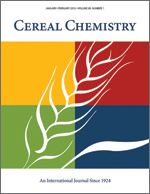
Cereal Chem 59:55 - 62. | VIEW
ARTICLE
Surface Hydrophobicity of Gliadin Components.
Y. Popineau and B. Godon. Copyright 1982 by the American Association of Cereal Chemists, Inc.
Gliadin components were fractionated, depending on their accessible (surface) hydrophobicity, by hydrophobic interaction chromatography (HIC) on phenyl- and octyl-Sepharose CL 4B. Hydrophobicity was also estimated by measuring heptane-binding capacity. Several HIC procedures were compared, using modified pH and eluting solvent polarity. The adsorption of gliadins to hydrophobic gels depended on the nature of the ligand attached to the matrix; the binding was stronger on phenyl- than on octyl-Sepharose, but nonspecific hydrophobic interactions played the leading role in the adsorption, even though aromatic stacking obviously occurred on phenyl-Sepharose. Fractionation patterns on phenyl-Sepharose were different for proteins solubilized in aluminum lactate buffer and those solubilized in acetic acid, due to conformational changes in the macromolecules. On octyl-Sepharose, the behavior of gliadins also varied with the eluant, but the cause was not clearly established. The combination of a pH increase and a linear gradient of ethanol concentration gave a satisfactory fractionation of gliadins on phenyl-Sepharose. Electrophoretically defined gliadins are not composed of proteins of identical hydrophobicity, and some components were eluted as several distinct HIC fractions. Hydrophobicity of gliadins was generally high but variable. No relation was observed between HIC results and hydrophobicity calculated from amino acid compositions of fractions, but correlation with heptane binding was good except for omega-gliadins. A rough comparative estimation of the surface hydrophobicity of gliadin components was made. The relationship between gluten structure and the functional properties of gliadins is discussed.